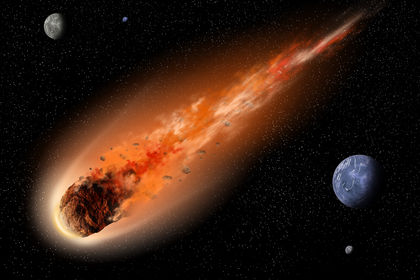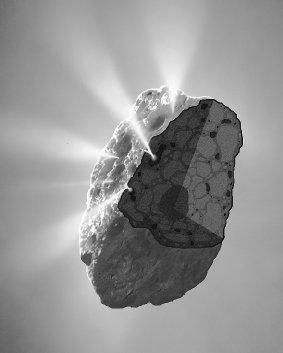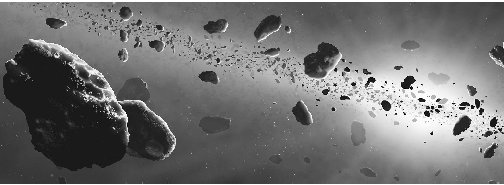How Asteroids and Comets Formed

Up until about the middle of the twentieth century, astronomers still possessed an imperfect notion of how and where asteroids and comets originally formed. The theory that asteroids were the remnants of the explosion of an ancient planet still prevailed. Also, astronomers believed that the vast majority of asteroids inhabited the asteroid belt between Mars and Jupiter. As for comets, scientists assumed they were floating collections of sand and pebbles that formed and moved randomly through the solar system. When one of these objects happened to stray too close to a planet, the larger body's gravity pushed the comet into the inner solar system (the region inhabited by Mercury, Venus, Earth, and Mars). There the comet grew a tail and became visible to observers on Earth.
Eventually, however, astronomers were forced to revise their theories about the origins of asteroids and comets. They rejected the concept that the asteroids formed from the explosion of a planet that once lay between Mars and Jupiter. It became clear that the mass of all the bodies in the asteroid belt put together is no more than a small fraction of Earth's mass. Therefore, the asteroid belt does not contain enough material to make up a full-fledged planet. In addition, astronomers found asteroids in other parts of the solar system. Their efforts to explain how these bodies left the asteroid belt helped to create a better understanding of how asteroids formed.
Astronomers also gained a better understanding of comets. Some researchers pointed out that the floating sandbank model for these bodies was inadequate. It did not account for a comet's ability to form a tail repeatedly during multiple visits to the Sun's neighborhood. For a long time, the assumption had been that many of the sand grains making up a comet were coated with ice, which melted as the comet approached the Sun; the resulting vapors formed the tail. But the revisionists concluded that this amount of ice would be depleted in only a single pass at the sun. The comet could form many tails

Formation of the Solar System
The revised vision of how asteroids and comets formed came to fit logically and neatly into the larger model scientists had developed to explain the formation of the entire solar system. This larger model is based on the solar nebula hypothesis (or nebular hypothesis), initially proposed in the eighteenth century by German philosopher Immanuel Kant and French mathematician Pierre-Simon Laplace. (The word nebula means a gaseous cloud.) According to the modern version of the theory, about 4.5 to 5 billion years ago the solar system developed out of a huge cloud of gases and dust floating through space. These materials were at first very thin and highly dispersed. But like all matter, they exerted a gravitational pull, which caused the particles of gas and dust to move slowly toward one another. More and more of the material fell toward the center, or core, of the nebula. And as this core grew increasingly compact, astronomer John Davies explains,
it increased in mass and so generated a more powerful gravitational field. This in turn attracted in more material, increasing the mass of the core still further in a rapidly accelerating process. As material fell in towards the center, it was slowed down by friction [particles rubbing against one another] and gave up its . . . energy as heat, gently warming the central regions of the core. . . . As the cloud got more and more dense, a point was reached when . . . heat could no longer escape easily and the temperature at the center began to rise rapidly. After a while conditions reached the point at which nuclear reactions could begin and . . . the star we call the sun was born. 16
Most of the remaining material in the initial cloud formed a flattened disk that continued moving around the infant Sun. It was from this disk of material that the planets, moons, comets, and asteroids would form. The parts of the disk that were not too close to the hot star began to cool and solidify into small particles of rock and ice. At the same time, gravity caused the particles to accrete, or stick to one another, thereby creating larger particles. Over time, this process caused larger and larger clumps to form, some of which grew to be thousands of feet or even several miles in diameter. Astronomers call these large clumps planetesimals, essentially meaning "planetary building blocks." As time went on, many of the planetesimals continued to grow. According to Curtis Peebles:
The planetesimals were ideal for sweeping up material. Like terrestrial [earthly] dustballs, the planetesimals had a loose, granular structure. The energy of any object hitting them would be absorbed, preventing it from rebounding. The object would be captured within the dustball. Once a few of the planetesimals had become larger than the others, they would begin to grow at an accelerated rate. Their gravitational attraction would begin to sweep up the surrounding dust, and the added mass would extend their reach. The process would affect objects of all sizes—dust grains would be trapped by tennis-ball-sized objects, which would then be captured by kilometer-sized planetesimals, which in turn would collide with objects made up of several planetesimals. The result would be large planetesimals that were loose aggregates [collections] of several smaller objects, all with differing compositions. 17
The largest accumulations of planetesimals became the planets and their principal moons, while the smaller accumulations, along with many even smaller individual planetesimals, became the asteroids and comets.
Creation of the Asteroid Belt
The main factors that made asteroids distinct from comets in the early solar system were the types of materials that made up these bodies and their distances from the central Sun when they formed. The planetesimals in the inner solar system, close to the hot Sun, tended to be composed of harder, more heat-resistant materials. These included iron and other metals and various kinds of rock. Most of these metallic and stony planetesimals were swept up by and became part of the inner planets.
In contrast, the hard planetesimals lying near the outer edge of the inner solar system, just beyond Mars, were unable to accrete into a planet. This was because of their close proximity to Mars's outer neighbor, Jupiter. By far the largest planet in the solar system, Jupiter exerted a powerful gravitational attraction that constantly pulled and pushed on these objects, keeping them from accreting into one or perhaps two or three large planetary bodies. Instead, these planetesimals remained separate. In this way, the asteroid belt came into existence. This scenario explains why swarms of asteroids orbit where a planet should be, showing that the rough planetary pattern described in the Titius-Bode Law is essentially correct.
But not all of these millions of bodies were destined to float forever, quietly and unimpeded, in the dark expanse of the asteroid belt. This region proved to be a violent, turbulent place, as two major forces immediately went to work on the newly formed planetesimals. The first of these forces was the brute shock of repeated collisions. In fact, says planetary scientist Clark R. Chapman, collisions among asteroids are the dominant factor affecting the lives of asteroids as they hurtle through the vast reaches of the solar system. "Asteroids are miniscule [tiny]," he says,
compared with the immensity of the [region] of space through which they travel. Yet there are enough of them moving sufficiently fast that major collisions are inevitable during the lifetime of the solar system for all but a lucky few asteroids. The typical collision velocity is about 5 km [3
miles] per second, involving a projectile that is most likely negligibly small compared to the target. Laboratory experiments and simulations suggest that for the largest impacts a typical asteroid might experience, the total energy is much more than sufficient to fracture and fragment an object having the material strength of solid rock. The only bodies that might be expected to survive such collisions more or less unscathed are (1) those with a cohesive strength exceeding that of iron, and (2) the very largest asteroids. 18 Millions of asteroids float in the asteroid belt after the solar system's formation. Jupiter's terrific gravity kept these objects from forming a planet.
Millions of asteroids float in the asteroid belt after the solar system's formation. Jupiter's terrific gravity kept these objects from forming a planet.
The second major force working on the planetesimals in the asteroid belt was Jupiter's immense gravity. Its gravity not only kept the original planetesimals in the region from forming a planet but also grabbed hold of the larger ones and forcibly ejected them from the belt. In the words of scientist John A. Wood:
Jupiter eliminated them in the same way it removes material from the belt today. . . . The process might be likened to using a swing. Small pushes applied at exactly the right moment during each cycle of the swing, make it go higher and higher. [In a like manner, an asteroid whose orbit has been affected by Jupiter] may collide with another asteroid, dive into the inner solar system (often hitting a planet or the sun itself), or soar out to Jupiter's orbit or beyond. Ultimately, something almost certainly happens to remove it from the asteroid belt. 19
The Kuiper Belt
The natural question is where did these asteroids go after Jupiter ejected them? As Wood points out, some ended up in the inner solar system, where they eventually collided with the inner planets or the Sun. Others left the solar system entirely, condemned to roam the black gulfs of interstellar space. Some of the ejected bodies, however, found new homes in the outer solar system, as Jupiter's gravity forced them into a belt of material lying beyond the orbits of the other three giant planets—Saturn, Uranus, and Neptune.
However, much of the material in this belt is not primarily metallic and stony in composition but, instead, largely icy. Indeed, the belt located beyond Neptune is a reservoir containing many of the planetesimals that formed in that cold region far from the Sun. As the early planetesimals were forming and growing, it was too hot in the inner solar system for ices to survive intact. Consequently, "most of the ices were evaporated and blown outwards," says Davies.
Farther out . . . temperatures were low enough that ices could survive. So, as well as dust, the outer regions of the [original solar] disk contained considerable amounts of water ice and frozen gases such as methane, ammonia, and carbon dioxide. . . . [Beyond the giant planets], although there was sufficient material to reach the stage of forming small planetesimals, there was not enough time, or enough material, for them to combine into a major planet. Instead, they formed a diffuse zone of icy objects in almost permanent exile at . . . the frozen boundary of the planetary region. 20
The existence of this belt of icy, cometary material mixed with some asteroids and lying beyond Neptune was only recently confirmed. As early as the 1940s and early 1950s, two researchers—English astronomer Kenneth Edgeworth and Dutch-born American astronomer Gerard Kuiper—suggested that such a belt might exist. But it was not until 1992 that scientists began actually finding objects in the region. It became known as the Kuiper Belt in Kuiper's honor, and bodies in the belt are called Kuiper Belt objects, or KBOs for short.
The first KBO was discovered by astronomers David Jewitt and Jane Luu and designated 1992 QB 1 . The object is approximately 190 miles in diameter and lies at a distance of 44 AU from the Sun. (AU is the abbreviation for "astronomical unit," the distance from Earth to the Sun, or about 93 million miles.) That is 14 AU beyond Neptune and about 4.5 AU beyond Pluto, the outermost planet. Only one-twenty-fifth the size of Mercury, Pluto is also the smallest planet in the solar system; many astronomers believe that it may be more accurate to call it a large KBO rather than a planet.
Pluto: Planet or Giant Comet?
Since its discovery in 1930, Pluto has been classified as the ninth planet in the solar system and the farthest planet from the Sun. However, most scientists now recognize that Pluto began as a large Kuiper Belt object and, accordingly, some of them believe it should be demoted from its planetary status. Scientist Paul R. Weissman (in an article in The New Solar System , by J. Kelly Beatty et al.) explains this belief in the following excerpt.
Although it is generally labeled as a planet, many solar system astronomers think of Pluto as the largest icy planetesimal to grow in the region beyond Neptune. While Pluto has a satellite and a thin atmosphere, traditionally considered proof of planetary status, we now know of asteroids with satellites, and satellites with atmospheres. Moreover, Pluto is smaller than Titan, Ganymede, Callisto, and Triton—all satellites of the Jovian [gas giant] planets. Consequently, Pluto's classification as a planet has increasingly been questioned, especially given its dynamical similarities to other objects in the Kuiper Belt.
Other large KBOs have been discovered. In the spring of 2001, searchers found 2001 KX 76 , also called Varuna, which is some 550 miles across. It is almost as big as Pluto's moon Charon (which is probably also a large KBO). An even bigger KBO about 800 miles across was found late in 2002. Dubbed 2002 LM 60 , or Quaoar, it lies about 51 AU from the Sun (or about 21 AU beyond Neptune). To date, more than five hundred large KBOs have been discovered, and experts estimate that millions or even billions of others exist.
The Oort Cloud
Although many of the bodies in the Kuiper Belt are icy in composition and are therefore comets by definition, that region is not the only cometary reservoir in the solar system. Just as Jupiter's gravity expelled a number of asteroids from the asteroid belt, the gravities of Jupiter, Saturn, Uranus, and Neptune ejected most of the millions of icy planetesimals that formed in the neighborhood of these giant planets. Some of these comets fell into the inner solar system to be absorbed by the Sun and inner planets. And a few were hurled beyond the Sun's grasp into interstellar space.
Most of these objects, however, ended up in a vast shell of comets (and a few asteroids) lying beyond Pluto in the solar system's outermost frontier. Discovered in the 1940s by Dutch astronomer Jan Oort, it was named the Oort Cloud in his honor. "The Oort Cloud is the result of a long game of interplanetary pinball," says noted comet hunter David H. Levy.
The youthful solar system was filled with comets—in Earth's primordial sky there must have been dozens of bright comets at a time. Some of the comets collided with the planets. Others made close passes by the planets, using their gravity to swing off into new orbits that would eventually land them near other planets. As the largest planet, Jupiter was the clear winner in this game. A comet swinging by Jupiter would get a gravitational hurl that would send the comet either out of the solar system forever, or off into the growing Oort Cloud. Within about 500 million years of the solar system's birth, the pinball game was all but over, its supply of cometary materials exhausted. . . . The process continues even today, but at a far more leisurely rate. 21
Astronomers estimate that the Oort Cloud extends from about ten thousand to one hundred thousand AU or more from the sun and contains millions of small icy bodies. (The latest estimate is that about 2 percent of the objects in the region are actually metallic-stony asteroids tossed there by the giant planets.) From time to time, collisions cause some of these comets to leave the Oort Cloud and move into the inner solar system, where a few pass close enough to Earth to become visible to the naked eye.
The orbits of the comets in the Oort Cloud can also be disturbed by other stars that occasionally pass near our solar system. This is because these objects lie far enough out that the Sun's gravitational pull on them is barely enough to keep them from floating away. As Paul R. Weissman, of the Jet Propulsion Laboratory (in Pasadena, California), puts it:
Oort showed that the orbits of the comets in the cloud were so weakly bound to the Sun that random passing stars could perturb them. Although stars rarely come very close to one another, on average about 10 to 12 stars must pass within 200,000 AU of the Sun every million years. Over the lifetime of the solar system, this is close enough to slowly stir the cometary orbits. . . . The perturbing influence of nearby stars also robs many comets of [their] momentum, causing them to "fall" toward the Sun and into the planetary region from all directions. 22
Thus, the present structure of the solar system, including its reservoirs of asteroids and comets, reflects the manner in which it formed. The largest planetesimals became the planets and moons, while the smallest ones became the asteroids and comets. Most of the asteroids, made up of metal and rock, formed in the asteroid belt, and most of the comets, composed primarily of ices, ended up in the more distant Kuiper Belt and Oort Cloud. This more or less tidy situation was the result of the giant planets cleaning up and finding storage places for the asteroids and comets—the refuse created during the solar system's messy birth.
Thanks!
Thanks!